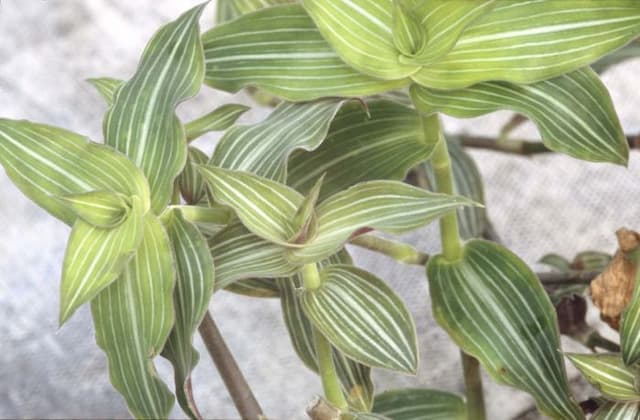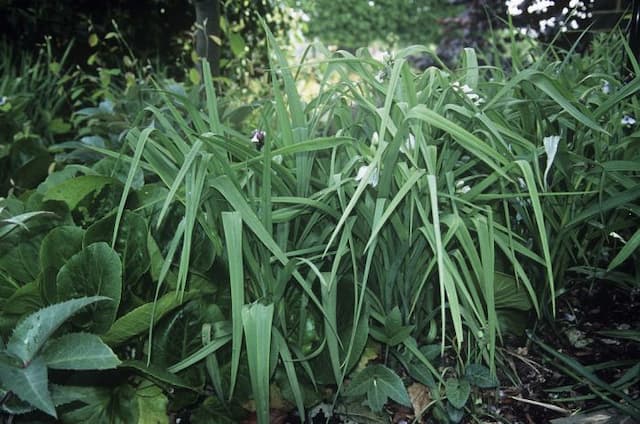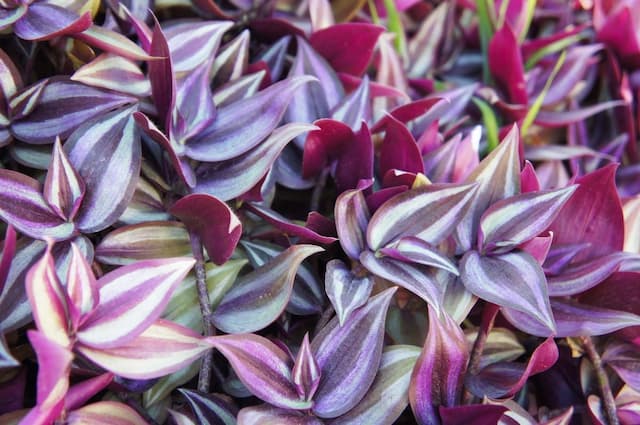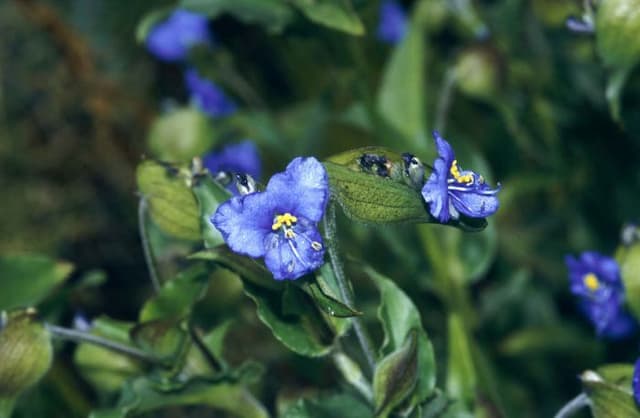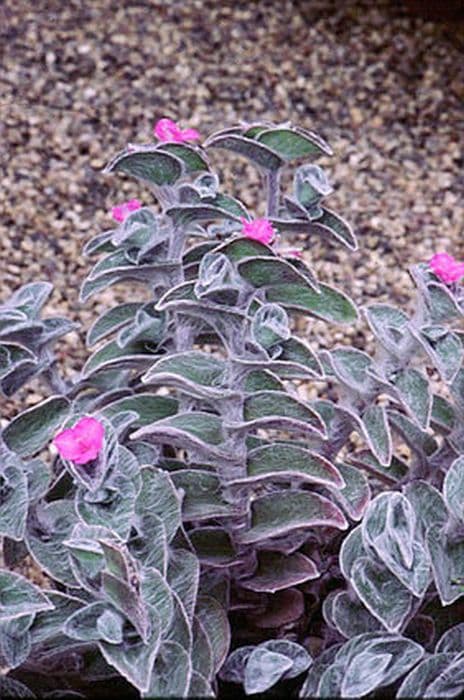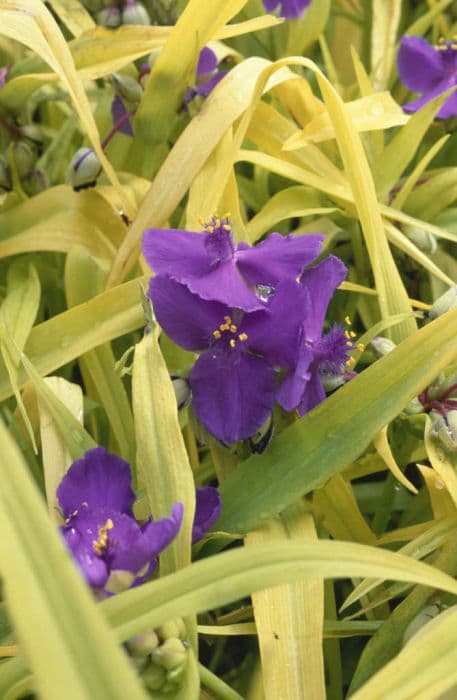Inch Plant Tradescantia zebrina 'Quadricolor' (v)

ABOUT
The Tradescantia zebrina 'Quadricolor,' commonly known as the silver inch plant, has a striking and colorful appearance. This variety of the inch plant is particularly noted for its leaves, which typically feature a combination of colors, hence the name 'Quadricolor.' Each leaf is oval-shaped with a pointed tip, exhibiting a unique pattern that includes shades of green, cream, pink, and purple. The colors form variegated stripes that run longitudinally along the leaves, creating a zebra-like pattern. This pattern is most vibrant on the upper surface of the leaf, while the underside typically shows a deep purple hue which further enhances its ornamental appeal. Its leaves are fleshy and have a succulent-like quality, making them both soft and slightly pliable to the touch. The silver inch plant is a trailing plant, meaning that it grows long, vine-like stems that hang down or sprawl over the sides of the container it is planted in. This growth habit makes it an excellent choice for hanging baskets or as a ground cover in appropriate climates when planted outdoors. Throughout the growing season, the plant may also produce small, tri-petaled flowers. These blooms are usually a pale lavender or pink color, which adds to the decorative quality of the plant, although the flowers are often less noticeable than the vivid foliage. In terms of its overall presentation, the silver inch plant is best known for its cascading stems and striking, multicolored leaves that make it a popular choice for adding a splash of color indoors or in sheltered garden spaces.
About this plant
 Names
NamesFamily
Commelinaceae
Synonyms
Inch Plant, Wandering Jew, Wandering Willie, Spiderwort
Common names
Tradescantia zebrina 'Quadricolor' (v)
 Toxicity
ToxicityTo humans
The Tradescantia zebrina, commonly known as Wandering Jew, is not highly toxic to humans. However, ingestion of this plant may cause mild irritation of the mouth, lips, throat, and skin for some people. If ingested, it is recommended to rinse the mouth and drink water to ease the irritation. Seek medical attention if symptoms persist or worsen.
To pets
The Wandering Jew is considered to be non-toxic to cats, dogs, and other pets. However, gastrointestinal upset could occur if your pet ingests large quantities of the plant. Symptoms might include vomiting or diarrhea. If you notice your pet exhibiting any unusual behavior after ingesting this plant, it's advisable to contact your veterinarian.
 Characteristics
CharacteristicsLife cycle
Perennials
Foliage type
Evergreen
Color of leaves
Mixed
Height
0.5-1 feet (15-30 cm)
Spread
1-2 feet (30-60 cm)
Plant type
Herb
Hardiness zones
9
Native area
Mexico
Benefits
 General Benefits
General Benefits- Easy to Care For: Tradescantia zebrina 'Quadricolor' is known for being low-maintenance, requiring minimal care to thrive.
- Aesthetically Pleasing: The plant features striking variegated leaves with shades of green, pink, red, and silver, adding a splash of color to any space.
- Fast Growing: This vigorous plant can grow quickly, which makes it satisfying for gardeners who want to see rapid progress in their plant's development.
- Propagation: It is easily propagated through stem cuttings, making it convenient for gardeners to create new plants and expand their collection.
- Versatility: The plant can be grown both indoors and outdoors in suitable climates, providing flexibility in placement and use.
- Enhances Mood: The vibrant foliage of the Wandering Jew plant can help brighten living spaces, which may contribute to improved mood and well-being.
 Medical Properties
Medical PropertiesThis plant is not used for medical purposes.
 Air-purifying Qualities
Air-purifying QualitiesThis plant is not specifically known for air purifying qualities.
 Other Uses
Other Uses- Photography Prop: Tradescantia zebrina 'Quadricolor' can be used as a vibrant, colorful subject or backdrop in macro photography due to its unique foliage.
- Crafting Material: The leaves and stems can be incorporated into handmade wreaths or floral arrangements for decorative purposes.
- Educational Tool: This plant can be used in classrooms to teach about plant propagation as it roots easily from cuttings.
- Fish Tank Decoration: Aquarists sometimes use this plant to add foliage to their freshwater tanks, although it is not fully aquatic.
- Bookmarks: The dried leaves of Tradescantia zebrina 'Quadricolor' can be laminated and used as natural, artistic bookmarks.
- Fashion Inspiration: The striking patterns of the leaves can inspire textile designs and fashion prints.
- Culinary Garnish: Although not commonly consumed, the colorful leaves can be used as a non-toxic garnish for plating dishes.
- Color Dye: Juice from the leaves can potentially be used as a natural dye for fabrics or paper.
- Mood Enhancer: Owing to its vibrant appearance, the plant may be used in spaces designed with color therapy principles in mind.
- Stop-motion Animation: Due to its distinct appearance, the plant can be used as a character or prop in stop-motion animation projects.
Interesting Facts
 Feng Shui
Feng ShuiThe wandering jew is not used in Feng Shui practice.
 Zodiac Sign Compitability
Zodiac Sign CompitabilityThe wandering jew is not used in astrology practice.
 Plant Symbolism
Plant Symbolism- Adaptability: Known for its hardiness in various conditions, Tradescantia zebrina represents the ability to thrive in different environments, symbolizing adaptability and versatility in life.
- Survival: This plant can easily regrow from cuttings, symbolizing regeneration and the resilience to overcome obstacles and challenges.
- Growth: The fast-growing nature of the Tradescantia zebrina symbolizes personal growth and expansion, encouraging one to strive for continuous improvement.
- Protection: It has a history of being used in folk medicine, which gives it a symbolism of healing and protection against illness.
 Water
WaterThe Inch Plant should be watered regularly, enough to keep the soil consistently moist but not soggy. Generally, this equates to approximately once a week, but this can vary based on environmental conditions such as temperature and humidity. It's best to water the plant thoroughly until excess water drains out of the bottom of the pot—this might be around 8-16 ounces for smaller pots or up to a gallon for larger pots, depending on the size of the pot and the plant. Always adjust the frequency and amount based on the plant's response and the dampness of the soil.
 Light
LightInch Plants thrive in bright, indirect light. The perfect spot would be near a window with a sheer curtain providing a buffer against direct sunlight, especially during the harsh midday sun which can bleach the leaves. They can tolerate some direct sun, especially in the morning or late afternoon, but excessive exposure can damage the foliage.
 Temperature
TemperatureInch Plants prefer warm temperatures between 65°F to 80°F for ideal growth. They can survive in temperatures as low as 50°F but shouldn't be exposed to temperatures below this as it can cause cold damage to the plant. It's important to keep the plant away from drafts and extreme temperature fluctuations for it to thrive.
 Pruning
PruningPruning Inch Plants is beneficial for maintaining a bushy and full appearance and should be done as needed to remove any leggy or dead growth. The best time to prune is in the spring or early summer, which encourages new growth and allows the plant to recover quickly. Pinching back the tips can also help to stimulate more lush growth.
 Cleaning
CleaningAs needed
 Soil
SoilThe Wandering Jew 'Quadricolor' thrives in a well-draining, peaty soil mixture with an addition of perlite or coarse sand to improve aeration. A pH ranging between 6.0 and 7.0 is suitable for this plant. It's important to ensure the soil is moist but not waterlogged to prevent root rot.
 Repotting
RepottingWandering Jew 'Quadricolor' should be repotted every 1-2 years or when it becomes root-bound. Choose a container that is slightly larger than the current one with adequate drainage to accommodate growth.
 Humidity & Misting
Humidity & MistingWandering Jew 'Quadricolor' prefers high humidity levels, ideally around 40-60%. If indoor air is dry, consider using a humidifier or placing a water tray near the plant to maintain optimal humidity conditions.
 Suitable locations
Suitable locationsIndoor
Place in bright, indirect light and keep soil consistently moist.
Outdoor
Plant in partial shade; protect from intense afternoon sun.
Hardiness zone
9-11 USDA
 Life cycle
Life cycleThe life of a Tradescantia zebrina 'Quadricolor', commonly referred to as Wandering Jew or Inch Plant, begins with seed germination, where warmth, light, and moisture trigger the emergence of new seedlings. As they grow, these seedlings develop into juvenile plants showcasing variegated leaves with stripes of green, silver, white, and pink, depending on light exposure. In the vegetative stage, Wandering Jew plants spread quickly, sending out long, trailing stems that can easily root when they come into contact with soil. These plants may produce small, inconspicuous, three-petaled flowers, marking the reproductive stage, although flowering is infrequent in indoor conditions. If allowed to naturally propagate, stem fragments or cuttings will root and grow into new plants, exhibiting vegetative reproduction which is common for this species. The life cycle is completed when the plant eventually ages and dies back, which can take many years as long as environmental conditions are favorable and the plant is well-cared for.
 Propogation
PropogationPropogation time
Spring to Summer
The most popular method of propagating the Tradescantia zebrina 'Quadricolor', commonly known as Inch Plant or Wandering Jew, is through stem cuttings. Typically, the best time to propagate is during the spring or early summer when the plant is actively growing. To do this, cut a 4 to 6 inch (about 10 to 15 centimeters) section of stem from a healthy plant, making sure it has at least one node (the point on the stem where leaves are attached). Remove the leaves from the bottom inch (2.54 centimeters) of the cutting. Then, place the cutting in a glass of water or directly into moist soil. If using water, once roots develop to a length of about an inch (2.54 centimeters), the cutting can be transplanted into soil. Keep the soil moist but not waterlogged, and in a matter of weeks, the cutting will establish a root system and begin to grow as a new plant.

